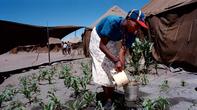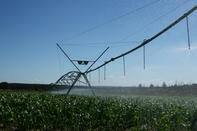
Crop Rotation
Crop rotation is always a good practice to follow as this limits the build up of certain pests. Some crops to rotate sweet corn with are: Ssy beans, potatoes, leafy vegetables, wheat and alfalfa. Yield (tonnes per hectare) Conservative: 10 tonnes Average: 15 tonnes Good: 25 tonnes+Harvesting

Harvesting of sweet corn is done when the cobs are slightly immature because most are sold for fresh consumption. This is between 9 and 14 weeks from planting depending on the cultivar selection and the weather conditions during the growing period, as cool weather slows growth and lengthens the growing period.
Harvesting should be done when the kernels have a milky juice and this is called the milky stage. Check the kernels by hand using your fingernail to break the kernel to check consistency of juice and if it is still clear the kernel is not ready.
The tassels on the top of the corn plant will have turned brown. Harvesting at the right stage is very important because once past the milky stage the kernels start to dry and lose their sweet flavour. Harvesting is done by hand on smaller plots and by a mechanical harvester on large commercial production units.
Storage
It is best to cool, transport and market sweet corn as soon as possible after harvest. Cooling temperatures are best at 0°C to 2°C at 95%+ relative humidity (RH).
If kept at this temperature and RH, sweet corn can be kept for 7 to 10 days without significant loss of quality. Thereafter they lose flavour and sugar and when placed at ambient temperature they lose quality and rapidly become inedible.